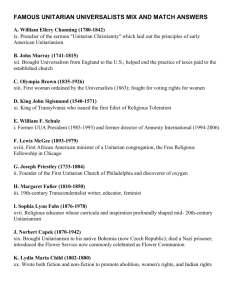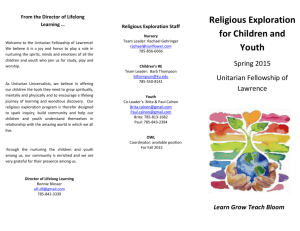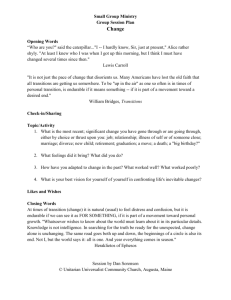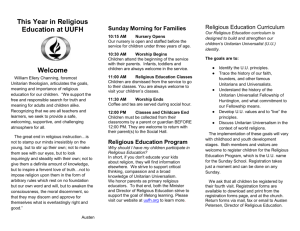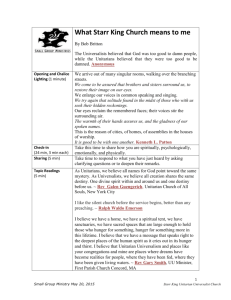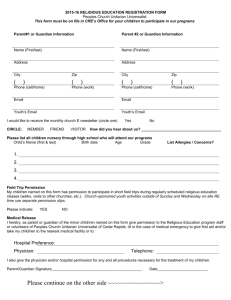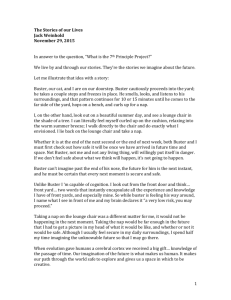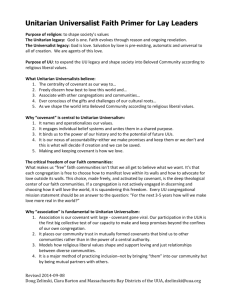Entire Session - Unitarian Universalist Association
advertisement
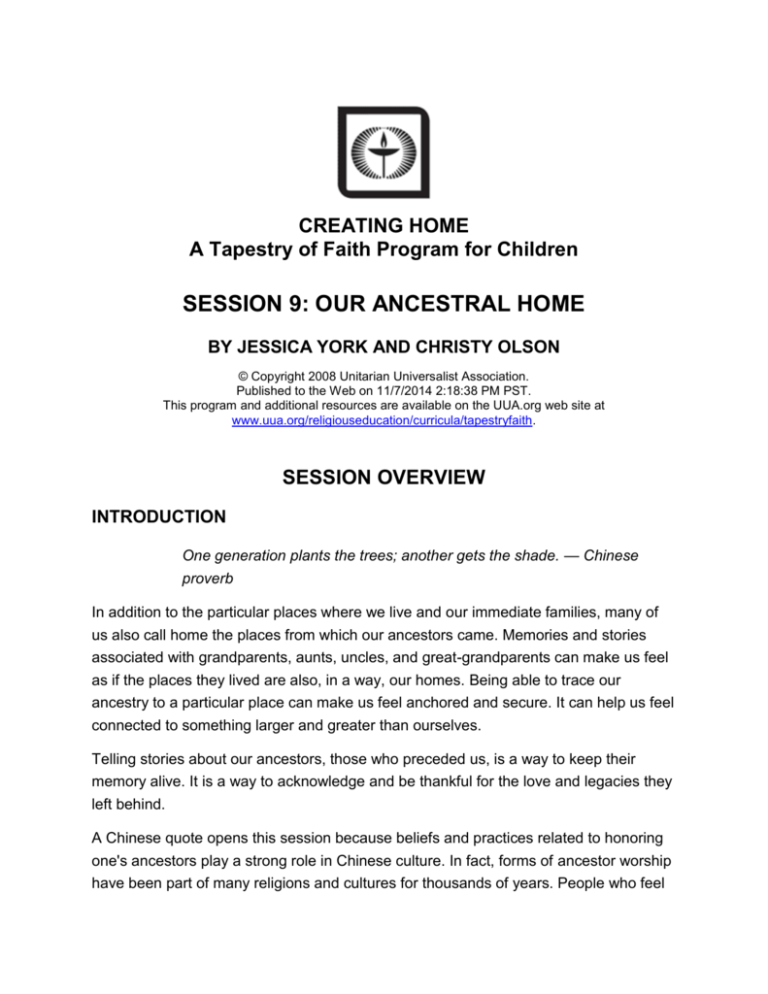
CREATING HOME A Tapestry of Faith Program for Children SESSION 9: OUR ANCESTRAL HOME BY JESSICA YORK AND CHRISTY OLSON © Copyright 2008 Unitarian Universalist Association. Published to the Web on 11/7/2014 2:18:38 PM PST. This program and additional resources are available on the UUA.org web site at www.uua.org/religiouseducation/curricula/tapestryfaith. SESSION OVERVIEW INTRODUCTION One generation plants the trees; another gets the shade. — Chinese proverb In addition to the particular places where we live and our immediate families, many of us also call home the places from which our ancestors came. Memories and stories associated with grandparents, aunts, uncles, and great-grandparents can make us feel as if the places they lived are also, in a way, our homes. Being able to trace our ancestry to a particular place can make us feel anchored and secure. It can help us feel connected to something larger and greater than ourselves. Telling stories about our ancestors, those who preceded us, is a way to keep their memory alive. It is a way to acknowledge and be thankful for the love and legacies they left behind. A Chinese quote opens this session because beliefs and practices related to honoring one's ancestors play a strong role in Chinese culture. In fact, forms of ancestor worship have been part of many religions and cultures for thousands of years. People who feel and express connections to their ancestors are creating a beloved community that extends beyond the lifetimes of the current generation. Where ancestor worship is practiced, many people believe that the spirits of their ancestors influence their daily lives. They may feel a moral or religious obligation to live their lives according to values and beliefs they have inherited from their ancestors. Belief in a real ancestral presence in our lives may seem strange to us. However, we, too, often desire to connect to those who went before us. We look for facial resemblances in newborns and treasure old family photographs. Most of all, we enjoy telling stories about these ancestors and how their lives differed from or mirror our own. As our family homes reflect our family ancestors, our Unitarian Universalist faith homes reflect those who came before us and helped to shape our denomination and our particular congregation. Many Unitarian Universalist find strength, wisdom, and affirmation of our Unitarian Universalist identity in the words and actions of Unitarian Universalist predecessors. Acknowledging these predecessors is an important way to keep our Unitarian Universalist heritage alive. Though we may not believe the spirits of our Unitarian Universalist ancestors influence our daily lives, exploring our kinship with our ancestors in faith can help us create a beloved community that extends both backward and forward in time. As we attend to the past, we realize we will be the ancestors of tomorrow's Unitarian Universalists. What sort of legacy will we leave for them? GOALS This session will: Introduce ancestors as those who came before us in our families, our families' ethnic and cultural heritages, our faith home, and our faith denomination Explore how ancestors can leave a legacy, and how we can receive it Introduce some Unitarian Universalist faith ancestors and their legacies LEARNING OBJECTIVES Participants will: Gain an explanation of the words "ancestor" and "legacy" Through a story, understand how ancestors can leave a legacy to those they love Learn about famous Unitarian Universalists Create a special place to honor our faith ancestors Learn and try a body prayer Optional: Discover who founded or shaped their faith home Optional: Hear of a Unitarian Universalist ancestor with whom the leader feels a personal connection SESSION-AT-A-GLANCE ACTIVITY MINUTES Opening 5 Activity 1: Black Crayon Legacies 10 Activity 2: Story — The Farmer's Legacy 8 Activity 3: Meet Your Unitarian Universalist Ancestors 12 Activity 4: Honoring Unitarian Universalist Ancestors 10 Activity 5: Body Prayer 10 Faith In Action: Founders Plaque Rubbing — Short-term 30 Closing 5 Alternate Activity 1: Your Favorite Unitarian Universalist Ancestor 15 SPIRITUAL PREPARATION Talking about ancestors can be complicated and potentially painful for some children. Some may have been adopted into their families. In essence, they belong to two family lines, and may lack information about their birth ancestors. Some may belong to an African American family line that was fractured during the era of U.S. slavery. Children whose families came to the U.S. as immigrants or refugees may be unable to trace their family ancestry very far. How far back does your family ancestry go? How might you feel differently about this topic if your ability to trace your ancestry were different? Look over all of the activities for this session through the lens of someone with few or no biological ancestors. Lacking information about a long family history is not necessarily bad: Unencumbered by ancestors, one gains the freedom to choose one's own roots. Think about advantages to both situations. See if you can get comfortable with a notion of ancestry that transcends biological ties. Spend a few minutes before the session sharing your reflections with your co-leader. SESSION PLAN OPENING (5 MINUTES) Materials for Activity Chalice candle or LED/battery-operated candle Lighter and extinguisher, if needed Labyrinth Basket of name stones Newsprint, markers, and tape Preparation for Activity Write the chalice-lighting words on newsprint, and post. Memorize the chalice-lighting words so you can make eye contact with participants while you say them. Spread the labyrinth on the floor with the chalice in the center. On top of the labyrinth, place the basket of stones. Description of Activity As children enter, invite them to retrieve their name stones from the basket and join you at the labyrinth. The labyrinth should be spread upon the floor with the chalice in the center and matches or a lighter at hand. Be aware of newcomers or guests in the room. Always have extra stones so you can offer the new people a chance to be part of the ritual. When all are seated, light the chalice and recite these opening words. Invite everyone to say with you: We are Unitarian Universalists, with minds that think, hearts that love, and hands that are ready to serve. Invite children to place their stones on the labyrinth, one at a time. Tell them they may share any joys or concerns they would like to when it is their turn to place their stone. You may say: When Unitarian Universalists come together, we often take time to tell one another about the joys and concerns going on in our lives. Joys are the things that make you feel happy. Concerns are worries. This is your time to share a joy or concern, if you would like to do so. Close the joys and concerns by affirming that it is very good to be together. Extinguish the chalice. ACTIVITY 1: BLACK CRAYON LEGACIES (10 MINUTES) Materials for Activity Plain 8 1/2 x 11" paper Crayons, black and a variety of different colors Plastic knives, coins, pencils, or other objects for participants to rub a layer of crayon off paper Optional: Store-bought multicolored scratch-art paper for all participants Preparation for Activity To make your own scratch-art paper, take a sheet of paper and cover it entirely by pressing down to color hard with a variety of colored crayons (but not black). Make a pattern of colors, if you choose. Then completely cover the sheet in black crayon so no other color shows. If you cut each sheet in half, you will have twice as many scratch-art sheets. Make sure you have enough for all participants. Optional: Purchase multicolor scratch-art paper from a craft store or toy store. Gather implements for children to rub the top, black layer of crayon off the paper. Description of Activity This activity helps children discover hands-on the meaning of the word "legacy" as something that others have left behind for you. Ask if anyone knows what the word "legacy" means. Confirm any definitions children suggest that are correct, or close. Tell the group you will show them what a legacy is like. Provide each child with a sheet of scratch-art paper and an implement sharp enough to rub off the top, black crayon layer (but not too sharp). Invite the children to use their implement as if it were a pencil for drawing, and rub off the black layer of crayon. Suggest they think about a design they would like to make, such as stripes, circles, a flower, or a sun. As they rub off the top layer of crayon, they will reveal the bright colors underneath. As children work on their pictures, explain that legacies are things left behind by people who came before us. Sometimes discovering a legacy can be a pleasant surprise — like scratching off the top color of our paper and finding many other colors underneath. Our ancestors — family members who lived before us — can leave us different kinds of legacies. ACTIVITY 2: STORY — THE FARMER'S LEGACY (8 MINUTES) Materials for Activity A copy of story, "The Farmer's Legacy" (included in this document) Preparation for Activity Review, download, and print out the story, "The Farmer's Legacy" Description of Activity Gather the children in a circle so they may sit comfortably and hear you tell the story. You may say, in your own words: Here is a story about one family's legacy. After I tell you this story, I am going to ask you what kind of legacy the farmer left for his children. So, listen carefully to figure out what the legacy might be. Read aloud or tell the story, "The Farmer's Legacy." When you have finished, ask the group what the legacy was. Help the children understand that the legacy was more than the fields. By leaving the fields for his children to farm, the old farmer made sure they would have good food and a reason and a place to stay together as a family. ACTIVITY 3: MEET YOUR UNITARIAN UNIVERSALIST ANCESTORS (12 MINUTES) Materials for Activity Three empty boxes with covers Items to fill the boxes, cut out from Unitarian Universalist Ancestor Boxes (included in this document) Optional: Additional items for each box Preparation for Activity Fill three empty boxes, such as shoeboxes, with items to represent the legacies of Charles Dickens, Hajom Kissor Singh, and Susan B. Anthony. Unitarian Universalist Ancestor Boxes provide pictures of all three, along with images of related items that reflect their legacies. Cover the boxes. Optional: Enhance the contents of each box with additional items, as suggested in Unitarian Universalist Ancestor Boxes. Optional: If you wish, make additional ancestor boxes to recall other Unitarian Universalists from the past. Include items that will help you explain their legacies to the group. Description of Activity Children will learn about some famous Unitarian Universalists and come to understand these individuals as their own faith ancestors. Say, in your own words: People don't have to be related to each other or live with each other to give or receive a legacy. People leave legacies to those who come after them because they love them. We know that you don't have to be related to love someone or consider them family. Sometimes people don't even realize they are leaving a legacy. Maybe someone from long ago just tried to live a good life and help other people. When we learn about someone like that, we might feel inspired by their life. Their legacy is that we want to try to live our lives the same way. Do you know any people who tried to live a good life and thereby set an example for us? Let the children give answers. If needed, prompt with people such as Jesus, Martin Luther King, Jr.; Mahatma Ghandi; Mother Theresa; Moses; Muhammad; Rosa Parks, or Harriet Tubman. Tell the group: When someone has led a life that inspires people, we frequently honor their memory. We might have a holiday just for thinking about that person and their legacy, like we do for Martin Luther King. Your parents or teachers might sometimes repeat that person's words. You might see a poster with that person's picture and some of their words, or even a movie about them. Unitarian Universalists are very fond of talking about famous Unitarians and Universalists from a long time ago. These are our Unitarian Universalist faith ancestors. They may not be related to us like someone in our family. But, we are connected to them by our common faith. They are our ancestors because they lived before us. The good things they did during their lives are a legacy that we get to share. Show the children the three legacy boxes you have made. Say, in your own words: Here on the table are three legacy boxes. Inside each one you will find some things to remind us of a legacy from one of our Unitarian Universalist ancestors. Invite each child to go to each box, lift one edge of its cover, and peek inside. Ask the children not to totally uncover the box, so everyone else has a chance to peek inside. After every child has had a turn, open one box at a time. Show everyone its contents and ask the children to describe what they see. The boxes are: Box #1: An image of Charles Dickens, a copy of A Christmas Carol and the movie Oliver! Box #2: An image of Hajom Kissor Singh, a map of India, a picture of a churchlike building Box #3: An image of Susan B. Anthony, a Susan B. Anthony dollar, a facsimile of a voting ballot Tell the group, in these words or your own, about each of these Unitarian Universalist ancestors and their legacies: Charles Dickens was a writer whose legacy included great stories, many of which have been made into plays and movies. People learned from his stories about how hard life can be for children who are poor. His stories inspired many people to take action to help others. Hajom Kissor Singh came to his Unitarian faith on his own, before he learned that others shared his beliefs. He founded Unitarian congregations in India. He helped spread our faith in a country that now has more than 30,000 Unitarian Universalists. Susan B. Anthony worked very hard to tell people why men and women should be allowed to do the same things. In her lifetime, women were not allowed to vote, and she believed this was not fair. Because of her work, our country changed its law so both men and women could vote. What great legacies these Unitarians left behind. Because we are Unitarian Universalists, these people are our faith ancestors. We honor them by remembering them, telling their stories, and trying to live lives that help other people, as they did. We try to put our Unitarian Universalist values into practice. ACTIVITY 4: HONORING OUR UNITARIAN UNIVERSALIST ANCESTORS (10 MINUTES) Materials for Activity Optional: Tablecloth and chalice Optional: Push pins or tape Preparation for Activity Designate a space to honor one or more of our faith ancestors. It could be a shelf, wall space, or a small table. If you have a table, you may like to cover it with a tablecloth and place a chalice on it. If you will use a wall space, you might identify the space, such as by posting blank, colored construction paper, before you start this activity; also, obtain push pins or tape. Optional: If you plan to use music, identify the music you would like to play and bring it to the session. Some music is suggested in the Leader Resources section. Description of Activity With the children, create a special place to honor our Unitarian Universalist faith ancestors. Ask the children how many have a wall or another place in their home where family photographs are displayed. Ask if any of the photographs are old or contain images of people who have died. Say in your own words: "Many houses have a place where families display photographs or objects that belonged to their ancestors. Sometimes, you will see a family member stop in front of this place and look at the photographs or objects. What do you think they might be thinking?" Children may offer that a parent is remembering his/her own parents or other relatives, or that someone might be wondering about the identity of someone represented in a photograph. After some responses, invite the children to create a special place to honor our Unitarian Universalist faith ancestors. Go to the place in your meeting space that you have chosen to be the "special place" for honoring ancestors. If you have a small table or shelf, place the objects from the three Unitarian Universalist Ancestor Boxes on the table. If you are using a wall space, invite some children to help you post items from the ancestor boxes. You may add other decorative or special objects to this place. You might explain that an altar is a place to offer religious or spiritual gifts. Let them know that you have chosen to use this special place as an altar to honor not just Anthony, Singh, and Dickens, but all our Unitarian Universalist faith ancestors, much like the way the name stones on the labyrinth symbolize the Creating Home community. Invite children to pick up their name stone from the labyrinth and place them gently on the special space you have created. Placing their stones symbolizes their connection to our Unitarian Universalist faith ancestors. Light the chalice. Your altar/centering table is now created. As a variation, if you wish to make this activity more ritualized, after you show the children the table or shelf, or wall space, explain what they will do next. Put on gentle music to play in the background. (See the Leader Resources section for a suggestion of music.) As the music plays, gently place the items from the Unitarian Universalist Ancestor Boxes on the altar. Light the chalice. Then, let each child go, one at a time, to get their stone and add it to the altar. If you use the music, slowly decrease the volume after the last child has placed a stone before going on to the next activity. Be sure to blow out the chalice when you are done. ACTIVITY 5: BODY PRAYER (10 MINUTES) Materials for Activity Optional: A copy of Singing the Living Tradition, the Unitarian Universalist hymnbook Optional: CD with a version of the song, "Spirit of Life" Preparation for Activity Review "Spirit of Life," Hymn #123 in Singing the Living Tradition. If you plan to sing or teach the song, make sure you know the tune. The Unitarian Universalist Association's online bookstore (at www.uuabookstore.org/showproducts.cfm?FullCat=48&step=1) offers several CDs with versions of "Spirit of Life;" hear the song (at secure.uua.org/bookstore/images/books/music/01%20spirit%20of%20life.mp3)p erformed by members of All Souls Church, Unitarian of Washington D.C. With your co-leader, create a series of simple body movements to accompany the song, "Spirit of Life." For example, "Spirit of Life, come unto me" could be arms outstretched and then crossed on the chest. Optional: If you will have time, plan to create the body movements with the group. Optional: If the group has not learned the song, "Spirit of Life," arrange to play a recording of the song while you teach the body movements to (or create body movements with) the group. Description of Activity Step away from the altar to introduce the idea of a body prayer. Tell the children that when people approach an altar, they often pray or meditate. Ask the group whether they have ever seen or heard anyone pray or mediate. Allow a few descriptions, if children offer some. Affirm that there are many different ways to pray or meditate. You may say: Some people might sing when they pray; other people might say some words quietly to themselves. Some people might sit very still and not say anything at all. All kinds of praying and meditation are ways for people to feel connected with something besides themselves. When people come to an altar or other special place to pray or meditate, they feel connected to whatever the altar is about. If the group has learned the song, "Spirit of Life," Hymn 123 in Singing the Living Tradition, remind them of the lines that refer to "roots" and "wings." We can find our "roots" in the connection we feel to our ancestors and use our "wings" to take us into the future as the next generation of Unitarian Universalists. Invite the group to sing it with you. Explain that we are going to meditate by moving our bodies. This can also be called a body prayer. Arrange the children in a circle around the altar/centering table where all can see you and all have room to move without bumping into one another. Sing the song, lead the group in singing the song, or play a recording of the song while you teach or create the body movements. Teach the group the movements you and your co-leader have chosen to accompany the song, or, you may choose instead to lead the group to invent their own movements. After performing the movements with the words, practice them without the words, in silence. This is now your body prayer. Lead the children in doing the body prayer a few times. Then, extinguish the chalice and invite the children to take their stones back to the labyrinth. Suggest that when children are feeling a little down or bored or tired, they might repeat the body prayer they learned. Maybe it will help them remember how important they are to their faith home and the people they see here when they come. It might make them feel better. They could do a body prayer in the morning when they wake up to greet the day. Or, they could do it at night in appreciation for the experiences that day has brought. Invite the children to teach it to their families, if they enjoyed it. Related content: Singing the Living Tradition (at http://www.uuabookstore.org/productdetails.cfm?PC=565) CLOSING (5 MINUTES) Materials for Activity Chalice candle or LED/battery-operated candle Lighter and extinguisher, if needed Labyrinth, with participants' name stones placed on it Basket for name stones Preparation for Activity Review Hymn 1008 in Singing the Journey, "When Our Heart Is in a Holy Place." Decide whether you prefer to have the children sing or recite the chorus words to close this session. If you will need the words and/or music to lead the group, place a copy of Singing the Journey near your chalice. Customize, print out, and photocopy the Taking It Home (included in this document) section for all participants. If you have a Word Wall, write the words "ancestor" and "legacy" with bold marker on index cards or post-its. Description of Activity Gather the group in a circle around the labyrinth. Relight the chalice. Tell the group that it is now time to share a closing ritual. Invite the children to take their stones from the labyrinth and return them to the basket. Then, ask a few volunteers to help you fold or roll the labyrinth and put it away. If you have a Word Wall, say: The words for our World Wall today are "ancestor" and "legacy." Show the group the index cards or post-its on which you have written "ancestor" and "legacy." Post them on the Word Wall, or ask a volunteer to do it. Next, invite everyone to hold hands and sing just the chorus to "When Our Heart Is in a Holy Place," Hymn 1008 in Singing the Journey. If you prefer, invite participants to recite the words to the song: When our heart is in a holy place, When our heart is in a holy place. We are blessed with love and amazing grace. When our heart is in a holy place. Say in your own words: Now we leave our classroom and go out into the world. May the memory of our faith ancestors help us be the kind of Unitarian Universalists in the world that we wish to be. See you next time! Extinguish the chalice. Distribute the Taking It Home handout you have prepared. Remind participants to give the handout to their parents. Thank and dismiss participants. Related content: Singing the Journey (at http://www.uuabookstore.org/productdetails.cfm?PC=571) FAITH IN ACTION: FOUNDERS PLAQUE RUBBING — SHORT-TERM (30 MINUTES) Materials for Activity Newsprint Masking tape Soft, thick sticks of chalk or pastels, in a variety of colors Preparation for Activity Locate on your congregational grounds a plaque that displays the names of congregation's founders, former ministers, lay leaders, or other past members who were recognized for a contribution to the life of the congregation. Optional: If the plaque you intend to take rubbings of is too high for children to reach, plan to bring a stable chair that a child can safely stand upon. Description of Activity Children will discover something about the congregation's founders or other important people in the history of their faith home. If your congregation has a plaque with the names of the original founding members, take the group on a walk to view it. Or, find another plaque that displays the names of people who played a role in the congregation's history. Read the names aloud and discuss with the group any other information you find on the plaque, such as date the congregation was founded. Explain that sometimes people take rubbings of tombstones. You may not have tombstones here at your faith home of the ancestors who started your congregation, but you have the plaque. You can take rubbings of that. Help children, one at a time, place their sheets of paper across the plaque. Tape each sheet down. Help children rub across the plaque with the chalk or pastels, varying the colors you give each child. After each child has completed a rubbing, return to your meeting space. Ask children to begin cutting out their rubbings. Help children as needed. Assemble the rubbings into a group collage for a bulletin board or wall. If you can obtain photocopies of photographs of the founding members or other past congregants whose names you have captured in the rubbings, include these in the collage. You can also include pictures or photographs of the building and other relevant decorations. Write a label for the collage, such as "The Founding of our Faith Home," and hang the collage in your meeting space or elsewhere in the congregational facilities. LEADER REFLECTION AND PLANNING This session has the potential to cover quite a bit of Unitarian Universalist history. Some children will be interested, some not. Do you feel you did a good job of tracking the group's interest level and adjusting as needed? How did the children react to the rituals around the altar? If they liked the altar and you are able to keep it intact in your meeting space, you may find ways to use it again in later sessions. TAKING IT HOME One generation plants the trees; another gets the shade. – Chinese proverb IN TODAY’S SESSION… The group talked about ancestors – both family and faith ancestors – and the legacies they leave for future generations. The children heard a story, “The Farmer’s Legacy,” in which a farmer coaxes his adult children to continue farming the land he plans to leave them, by telling them as he dies that a treasure is buried in the land. You can find the story on the Tapestry of Faith website (at www.uua.org/religiouseducation/curricula/tapestryfaith/index.shtml). Select this curriculum, Creating Home (Living Faith, Kindergarten/First Grade). Click on Session 9: Our Ancestral Home. Go to the Session 9 Resources section; look under “Stories.” As part of our discussion of ancestors we talked about the legacies of UU faith ancestors Hajom Kissor Singh, Susan B. Anthony, and Charles Dickens. Learning more about their faith ancestors may be very useful to children, particularly if you live in an area where few people are familiar with Unitarian Universalism. It will help them see how deep our roots go. We also created an altar and performed a body prayer to help connect us to our Unitarian Universalist faith ancestors. The body prayer is to the song, “Spirit of Life,” Hymn 123 in Singing the Living Tradition. See if your child can sing it with you. EXPLORE THE TOPIC TOGETHER. Talk about… Not all legacies are treasures worth a lot of money. Family traditions that your child knows quite well may contain legacies from your family ancestors. Talk together about the traditions you share as a family. How do you mark birthdays, national holidays, cultural holidays, or religious holidays? Are there traditions peculiar to your family, such as planting window boxes together each spring, or attending an annual reunion of extended cousins? Which of your traditions reflect a legacy from previous generations? Which break with, or modify, your ancestors’ ways? If your children are adopted, this is an excellent opportunity to talk about their birth ancestors and cultural legacies from the country(ies) of their birth family. You may want to share with your child the importance of certain family traditions to you. Find out which are important to your child. EXTEND THE TOPIC TOGETHER. Try… A Family Ritual In today’s session, children created an altar to acknowledge our shared Unitarian Universalist faith ancestors. Does your family home have an altar that honors and remembers your family ancestors? Perhaps you display photographs or other items that recall your forebears. Consider what it might feel like to gather these items as an altar. A Family Game UU of the Month. Your family might like to choose a different Unitarian Universalist to talk about every month. At a shared meal, have an adult or an older youth present a fact about a Unitarian Universalist ancestor. Then, invite everyone to chime in with their observations about how this ancestor’s life has affected their own. Is the UU of the Month a scientist? Maybe your child loves science, too. History becomes more real and much more fun when a personal connection is made. FAMILY DISCOVERY Some well known Unitarian Universalists were born into and raised in Unitarian, Universalist, or (more recently) Unitarian Universalist congregations. Many others came to our faith later in life. Peruse the Dictionary of Unitarian and Universalist Biography (at www.uua.org/uuhs/duub/index.html) to learn more about Béla Bartók, e. e. cummings, Julia Ward Howe, Linus Pauling, William Howard Taft, and many others. The KidTalk page (at clf.uua.org/kidtalk) from the (UU) Church of the Larger Fellowship (at www.clfuu.org/) also features a person from Unitarian and/or Universalist history each month. You can look back through the archives to find a variety of Unitarian Universalist heroes. Related content: Singing the Living Tradition (at http://www.uuabookstore.org/productdetails.cfm?PC=565) ALTERNATE ACTIVITY 1: YOUR FAVORITE UNITARIAN UNIVERSALIST ANCESTOR (15 MINUTES) Materials for Activity An empty box with a cover Items to fill the box Preparation for Activity Using Activity 3: Meet Your Unitarian Universalist Ancestors as a guide, fill the box with items to represent the legacy of a Unitarian Universalist whose life and accomplishments interest you. If you have not done Activity 3: Meet Your Unitarian Universalist Ancestors, find ideas and inspiration for creating a legacy box in the activity description and on Leader Resource 1, Unitarian Universalist Ancestor Boxes. Description of Activity Here is an opportunity to share something significant to you with the group. Introduce the children to a Unitarian Universalist faith ancestor with whom you feel a personal connection. Use the box activity described in Activity 3: Meet Your Unitarian Universalist Ancestors to share information about another Unitarian Universalist life and legacy. Gather the group and provide a brief description of the person you wish to introduce. Pass around the legacy box you have made. Invite children to ask questions about the person, and answer those that you can. Of course, you may use another activity. For instance, if you own a piece of Wedgwood, you might prepare a five-minute talk about Josiah Wedgwood and show the group your Wedgwood piece and pictures from the internet or books. You might ask a potter from the congregation to give a pottery demonstration. If the group has done Activity 4: Honoring Our Unitarian Universalist Ancestors, add to the altar an item that represents this additional ancestor. CREATING HOME: SESSION 9: STORY: THE FARMER’S LEGACY Once there was a farmer. He was very old and ill and knew he would soon die. He had lived a good life and his only regret was that his three children fought all the time. None of them seemed interested in taking care of the large farm the old man had established. They were rather lazy. The farm was big enough for several farmhouses and produced enough food to easily provide for any families his children might someday start. The only reason the old farmer had worked so hard his entire life was to leave a legacy to his children so their life would be easier. Now that his life was near its end, he wanted to find some way to help them see what a precious thing it is to be able to work your own land and provide for your family. So he did. One winter day, the old farmer called his children to his sick bed. “My children, I have accumulated great wealth.” “Where is this great wealth?”, they asked. “You have never seen it. It exists out, deep in the fields. That is where you will find your legacy.” A short time later, the farmer died. His children grieved, because they loved their father. Their sadness brought them together and they stopped fighting. One day, they decided to go looking for their legacy. “He said it is deep in the fields. It must be buried.” “We’ll need to dig for it.” So they dug and dug for days. They dug until they had dug up almost all the farmland, but they found nothing. One sibling said, “We have dug up all this land, but we haven’t found our legacy. We must have missed it and I am too tired to keep digging. Still, it is spring and time to plant crops. Since we have already dug up the earth, we might as well plant this field.” So they did. Fall came and after harvesting their crops, they set to digging again, looking for their legacy. They dug and dug for days. They dug until, once again, they had dug up almost all the farmland, but they found nothing. One sibling said, “We have dug up all this land, but we haven’t found our legacy. We must have missed it and I am too tired to keep digging. Still, it is spring and time to plant crops. Since we have already dug up the earth, we might as well plant as we did last year.” So they did. Yet again, fall came and they harvested their crops. This year’s harvest was even bigger than the year’s before. After the harvest, they dug for their legacy and, not finding it again, decided to plant their crops. This continued for a few years. During that time, they got married and started families and they lived comfortable lives off the money from selling their crops. They grew strong from working in the fields and no longer were lazy. They were healthy and happy. One spring, they all three realized that the rich land of the farm and being able to provide for themselves and their families was the true legacy their father left them. They stopped digging for treasure and started working the farm, happy that that their father had been wise enough to leave them this great gift. They decided that they would all share the land and take good care of it, so they could leave it to their children someday. And so they did. Everyone doesn’t own farmland to leave to his or her children. But every parent leaves something, a legacy to his or her children. It might be a house, but it could also be a value, like hard work. It might be beautiful necklace, but it could also be a belief or a religion, like Unitarian Universalism. The legacy might be a favorite book, but it could also be photographs and memories of special times. What about the way you look? Maybe you got your eye color from your great grandmother. Maybe you got your height from your dad’s side of the family. Maybe you get your sense of humor from your mother. Maybe your cousin is the person handing down the family recipe that goes back several generations. What did you receive as a legacy from an ancestor? CREATING HOME: SESSION 9: LEADER RESOURCE: ANCESTOR BOXES Susan B. Anthony (included in this document) Charles Dickens (included in this document) Hajom Kissor Sinjh (included in this document) CREATING HOME: SESSION 9: LEADER RESOURCE: CHARLES DICKENS Download a high-resolution PDF (at www.uua.org/documents/tapestry/home/dickens.pdf) for printing. CREATING HOME: SESSION 9: LEADER RESOURCE: HAJOM KISSOR SINGH Download a high-resolution PDF (at www.uua.org/documents/tapestry/home/kissor.pdf) for printing. CREATING HOME: SESSION 9: LEADER RESOURCE: SUSAN B. ANTHONY Download a high-resolution PDF (at www.uua.org/documents/tapestry/home/susananthony.pdf) for printing. FIND OUT MORE Read biographies of Charles Dickens (at www.uua.org/uuhs/duub/articles/charlesdickens.html) and Hajom Kissor Singh (at www.uua.org/uuhs/duub/articles/hajomkissorsingh.html) on the Dictionary of Unitarian and Universalist Biography. A 2003 sermon by Unitarian Universalist minister Chris Buice, "The Real Value of a Susan B. Anthony Dollar (at www.tvuuc.org/audioservices/sermons/2003/03/02/20030302.doc)," discusses Susan B. Anthony's legacy. The About.com website offers a brief biography and images of Anthony (at womenshistory.about.com/library/bio/blanthony.htm). Here are two versions of the story well known for Scrooge, Tiny Tim, and "God bless us, every one!": A Christmas Carol by Charles Dickens, illustrated by Carter Goodrich (New York: Morrow Junior Books, 1996) A Christmas Carol by Charles Dickens, illustrated by Greg Hildebrandt (New York: Simon & Schuster, 1983)
